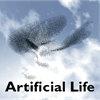Modeling the Mutation and Competition of Certain Nutrient-Producing Protocells by Means of Specific Turing Machines
IF 1.5
4区 计算机科学
Q4 COMPUTER SCIENCE, ARTIFICIAL INTELLIGENCE
引用次数: 0
Abstract
It is very important to model the behavior of protocells as basic lifelike artificial organisms more and more accurately from the level of genomes to the level of populations. A better understanding of basic protocell communities may help us in describing more complex ecological systems accurately. In this article, we propose a new comprehensive, bilevel mathematical model of a community of three protocell species (one generalist and two specialists). The aim is to achieve a model that is as basic/fundamental as possible while already displaying mutation, selection, and complex population dynamics phenomena (like competitive exclusion and keystone species). At the microlevel of genetic codes, the protocells and their mutations are modeled with Turing machines (TMs). The specialists arise from the generalist by means of mutation. Then the species are put into a common habitat, where, at the macrolevel of populations, they have to compete for the available nutrients, a part of which they themselves can produce. Because of different kinds of mutations, the running times of the species as TMs (algorithms) are different. This feature is passed on to the macrolevel as different reproduction times. At the macrolevel, a discrete-time dynamic model describes the competition. The model displays complex lifelike behavior known from population ecology, including the so-called competitive exclusion principle and the effect of keystone species. In future works, the bilevel model will have a good chance of serving as a simple and useful tool for studying more lifelike phenomena (like evolution) in their pure/abstract form.用特定图灵机模拟某些产生营养物质的原始细胞的突变和竞争。
从基因组水平到种群水平越来越精确地模拟原始细胞作为基本的类生命人工生物的行为是非常重要的。更好地了解基本的原始细胞群落可以帮助我们准确地描述更复杂的生态系统。在这篇文章中,我们提出了一个新的综合的,双层的数学模型,一个由三个原始细胞物种组成的群落(一个通才和两个专才)。其目的是实现一个尽可能基本的模型,同时已经展示了突变、选择和复杂的种群动态现象(如竞争排斥和关键物种)。在遗传密码的微观层面上,原始细胞及其突变用图灵机(TMs)建模。专才是由通才通过变异而产生的。然后,这些物种被放到一个共同的栖息地,在那里,从种群的宏观层面来看,它们必须竞争可用的营养物质,其中一部分是它们自己可以生产的。由于不同类型的突变,物种作为TMs(算法)的运行时间是不同的。该特性作为不同的复制时间传递到宏观级别。在宏观层面上,一个离散时间动态模型描述了竞争。该模型展示了种群生态学中已知的复杂的类生命行为,包括所谓的竞争排斥原理和关键物种的影响。在未来的工作中,双层模型将有很好的机会作为一个简单而有用的工具,以纯/抽象的形式研究更逼真的现象(如进化)。
本文章由计算机程序翻译,如有差异,请以英文原文为准。
求助全文
约1分钟内获得全文
求助全文
来源期刊

Artificial Life
工程技术-计算机:理论方法
CiteScore
4.70
自引率
7.70%
发文量
38
审稿时长
>12 weeks
期刊介绍:
Artificial Life, launched in the fall of 1993, has become the unifying forum for the exchange of scientific information on the study of artificial systems that exhibit the behavioral characteristics of natural living systems, through the synthesis or simulation using computational (software), robotic (hardware), and/or physicochemical (wetware) means. Each issue features cutting-edge research on artificial life that advances the state-of-the-art of our knowledge about various aspects of living systems such as:
Artificial chemistry and the origins of life
Self-assembly, growth, and development
Self-replication and self-repair
Systems and synthetic biology
Perception, cognition, and behavior
Embodiment and enactivism
Collective behaviors of swarms
Evolutionary and ecological dynamics
Open-endedness and creativity
Social organization and cultural evolution
Societal and technological implications
Philosophy and aesthetics
Applications to biology, medicine, business, education, or entertainment.
 求助内容:
求助内容: 应助结果提醒方式:
应助结果提醒方式:


